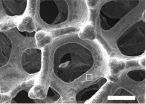Researchers rethink how our feathered friends evolved
SDSC's Gordon supercomputer assists in landmark genome study
2015-03-17
(Press-News.org) A recently published global genome study that used the data-intensive Gordon supercomputer at the San Diego Supercomputer at the University of California, San Diego, has researchers rethinking how avian lineages diverged after the extinction of the dinosaurs.
The four-year project, called the Avian Genome Consortium and published in the journal Science, resulted in a new family "tree" for nearly all of the 10,000 species of birds alive today by comparing the entire DNA codes (genomes) of 48 species as varied as parrot, penguin, downy woodpecker, and Anna's hummingbird. The massive undertaking, started in 2011, involved more than 200 researchers at 80 institutions in 20 countries, with related studies involving scientists at more than 140 institutions worldwide.
The genome-scale phylogenetic analysis of the 48 bird species considered approximately 14,000 genes. This presented computational challenges not previously encountered by researchers in smaller-scale phylogenomic studies based on analyses of only a few dozen genes. The inclusion of hundreds of times more genetic data per species allowed the researchers to realize the existence of new inter-avian relationships.
"Characterization of genomic biodiversity through comprehensive species sampling has the potential to change our understanding of evolution," wrote Erich Jarvis, associate professor of neurobiology at the Howard Hughes Medical Institute at Duke University and the study's principal investigator, in an introduction to a special issue of the journal Science containing eight papers from the study. An additional 20 papers generated by the study were simultaneously published in other journals.
"For 50 species, more than 10 to the power of 76 possible trees of life exist. Of these, the right one has to be found," said Andre J. Aberer, with the Heidelberg Institute for Theoretical Studies (HITS), in a news release at the time of the study's publication in Science. "For comparison: About 10 to the power of 78 atoms exist in the universe."
Many of the computations were done on SDSC's Gordon supercomputer by Aberer with the assistance of SDSC Distinguished Scientist Wayne Pfeiffer. They ran a new code called ExaML (Exascale Maximum Likelihood) to infer phylogenetic trees using Gordon soon after it debuted in 2012 as one of the 50 most powerful supercomputers in the world.
Developed by Alexandros Stamatakis, head of the Scientific Computing Group at HITS, ExaML couples the popular RAxML search algorithm for inference of phylogenetic trees using maximum likelihood with an innovative MPI parallelization approach. This yields improved parallel efficiency, especially on partitioned multi-gene or whole-genome data sets.
"I had previously collaborated with Alexis on improving the performance of RAxML," said Pfeiffer. "He described the goals of the Avian Genome Consortium, and we agreed that Gordon, with its just-released fast processors, could provide much of the computer time needed for this ambitious project. In the end, more than 400,000 core hours of computer time were consumed on Gordon."
"After doing initial analyses on our institutional cluster, we rapidly realized that comprehensive analysis of the more challenging data sets being considered would require supercomputer resources," said Aberer. "Access to Gordon was thus invaluable for achieving results in a timely manner."
In all, high-performance computing (HPC) resources at nine supercomputer centers were used to analyze the complete genomes because of the scope of the undertaking. In addition to Gordon, several other U.S.-based supercomputers that are or have been part of the National Science Foundation's eXtreme Science Engineering and Discovery Environment (XSEDE) were used: Ranger, Lonestar, and Stampede at the Texas Advanced Computing Center (TACC) at the University of Texas at Austin; and Nautilus at the National Institute of Computational Sciences (NICS) at the University of Tennessee.
Resolving the timing and phylogenetic relationships of birds is important not only for comparative genomics, but can also inform about human traits and diseases, according to the researchers. For example, the study included vocal-learning species - such as parrots and hummingbirds - which can serve as models for spoken language in humans and may prove useful for insights into speech disorders.
INFORMATION:
ELSE PRESS RELEASES FROM THIS DATE:
2015-03-17
SAN DIEGO (March 16, 2015) -- Patients who experience the deadliest form of heart attack--ST segment elevation myocardial infarction (STEMI)--and suffer from substantial narrowing in multiple heart arteries may benefit from receiving angioplasty in constricted arteries not affected by the heart attack, thereby reducing the need for future angioplasty, according to research presented at the American College of Cardiology's 64th Annual Scientific Session.
The study is the largest prospective, controlled trial to evaluate whether patients should receive preventive angioplasty, ...
2015-03-17
OAKLAND, Calif. -- Specific system-level factors controlled by health care systems - including prescriptions with a medication supply greater than 90 days, mail-order pharmacy use, and lower copayments and out-of-pocket maximums - nearly doubled the likelihood that patients adhered to prescribed heart and diabetes medications, according to a new study published in the journal Medical Care.
"This study is the first to look at all four of these system-level factors at once in the senior population," said Julie A. Schmittdiel, PhD, research scientist with the Kaiser Permanente ...
2015-03-17
If you're a fan of food television, it's fine to be entertained by the programming, but if you take recipes for the rich meals the networks favor into your own kitchen, you're at risk of putting on pounds, according to a study just published online by the journal Appetite.
"The message is clear," said Lizzy Pope of the University of Vermont, the study's lead author. "Food TV should be a viewing experience only, not a cooking experience."
The study asked 501 women, aged 20 to 35, where they obtained information about new foods, how frequently they cooked from scratch, ...
2015-03-17
Healthy bone is continuously involved in a dynamic process that includes bone deposition and bone resorption. However, when a person has cancer that spreads to the bone and bone marrow, the tissue becomes increasingly fragile, and this process is disrupted, usually leading to increased bone resorption.
In an early online edition in advance of publication in the International Journal of Cancer, investigators at Children's Hospital Los Angeles reported a surprising discovery - when neuroblastoma (NB) cells metastasize to the bone, there initially occurs an increase in bone ...
2015-03-17
Berkeley -- Engineers at the University of California, Berkeley, are developing a new type of bandage that does far more than stanch the bleeding from a paper cut or scraped knee. Thanks to advances in flexible electronics, the researchers, in collaboration with colleagues at UC San Francisco, have created a new "smart bandage" that uses electrical currents to detect early tissue damage from pressure ulcers, or bedsores, before they can be seen by human eyes - and while recovery is still possible.
"We set out to create a type of bandage that could detect bedsores as ...
2015-03-17
UNSW Australia scientists have developed a highly efficient oxygen-producing electrode for splitting water that has the potential to be scaled up for industrial production of the clean energy fuel, hydrogen. The new technology is based on an inexpensive, specially coated foam material that lets the bubbles of oxygen escape quickly.
"Our electrode is the most efficient oxygen-producing electrode in alkaline electrolytes reported to date, to the best of our knowledge," says Associate Professor Chuan Zhao, of the UNSW School of Chemistry.
"It is inexpensive, sturdy and simple ...
2015-03-17
Tuesday, March 17, 2015. Just like milk and many other foods, blood used for transfusions is perishable. But contrary to popular belief, new research shows that blood stored for three weeks is just as good as fresh blood - findings published today in the New England Journal of Medicine.
The large clinical trial provides reassuring evidence about the safety of blood routinely transfused to critically ill patients. Supported by the Canadian Critical Care Trials Group and countless nurses, blood bank technologists, transfusion medicine and critical care physicians, Drs. ...
2015-03-17
Ann Arbor, MI, March 17, 2015 -- Suicide is responsible for more than 36,000 deaths in the United States and nearly 1 million deaths worldwide annually. In 2009, suicides surpassed motor vehicle crashes as the leading cause of death by injury in the U.S. A new study published in the American Journal of Preventive Medicine analyzes the upward trend of suicides that take place in the workplace and identifies specific occupations in which individuals are at higher risk. The highest workplace suicide rate is in protective services occupations (5.3 per 1 million), more than ...
2015-03-17
(Chicago) - Just as humans will travel to their favorite restaurant, chimpanzees will travel a farther distance for preferred food sources in non-wild habitats, according to a new study from scientists at Chicago's Lincoln Park Zoo that publishes on March 17 in the journal PeerJ.
Chimpanzees at Lincoln Park Zoo prefer grapes over carrots. Previous research at the zoo provided that insight into food preferences. Now, a 15-month study, led by Lydia Hopper, PhD of the Lester Fisher Center for the Study and Conservation of Apes at Lincoln Park Zoo, suggests that the apes ...
2015-03-17
Toronto, ON (March 17, 2015) - A comprehensive study examining clinical trials of more than 95,000 patients has found that glucose or sugar-lowering medications prescribed to patients with diabetes may pose an increased risk for the development of heart failure in these patients.
"Patients randomized to new or more intensive blood sugar-lowering drugs or strategies to manage diabetes showed an overall 14 per cent increased risk for heart failure," says Dr. Jacob Udell, the study's principal investigator, and cardiologist at the Peter Munk Cardiac Centre, University Health ...
LAST 30 PRESS RELEASES:
[Press-News.org] Researchers rethink how our feathered friends evolved
SDSC's Gordon supercomputer assists in landmark genome study



